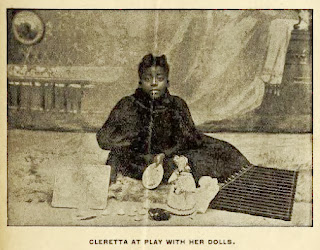Today the Scribe machine at Duke University scanned the 2,000th volume since beginning production in October of 2012. The pamphlet, entitled The Life of Cleretta Nora Avery - the Wonderful Colored Girl Preacher, focuses on the life and family background of a 10-year-old prodigy who took the 19th century United States by storm with her oratorial skills. Written by her mother, Mrs. Victoria Georgie Avery (nee Andrews) and published in 1897, the pamphlet includes biographical information on her and Cleretta's father, Moses Brown Avery. While their daughter Cleretta is the focus, Mr. and Mrs. Avery didn't lead boring lives by any stretch of the imagination.
Originally from Pensacola, Florida, Moses grew up in Mobile, Alabama. He was brought there when he and his mother were freed from slavery by his white father, and was raised as an Episcopalian. He distinguished himself in his studies, and was one of the few African American officers in the Union Navy during the Civil War. Meanwhile, Victoria (also born in Pensacola, but to Latino and African American parents) knew Moses while growing up in Mobile. She survived the Civil War, and an attempt to sell her into slavery, by fleeing first to Texas and then alone on horseback into Mexico. When she returned to Mobile at the war's conclusion, she found Moses, who was involved in publishing and post-war administration in both Louisiana and Alabama. They married, and Cleretta was born around 1887. Moses was devoted to the African Methodist Episcopal (A.M.E.) Zion Church , and had been ordained therein as a minister at some point during his life. According to Mrs. Avery, Cleretta was converted at the tender age of 18 months. Intelligent and outspoken, at the age of 3 she declared her intention to follow in her father's footsteps and preach, and did give her first sermon in Raleigh several years later at the age of 6. Her mother writes:
It was certainly marvelous to behold the command of language, knowledge of the Bible and elocutionary powers exhibited by her in this first sermon, of one half hour long, delivered to a large congregation. That sermon made her famous. Invitations to preach from churches and from white and colored people in the adjoining cities and towns poured in upon this tiny little preacher. (p. 7-8)Cleretta Nora Avery and her mother went on an evangelical tour, continuing even after Moses' death in Aberdeen, N.C. in 1895. Cleretta preached in North and South Carolina at first, but expanded her range to include Virginia, New York, New Jersey, and Massachusetts, among other states. This pamphlet includes letters of commendation, praise, and admiration written to her by various preachers, including Rev. Dr. J.S. Caldwell of New York and Pastor J.H. Welch of Charleston. Despite this fame and ability to preach, Cleretta seems to have been a normal child in many other aspects, which is reflected in a charming newspaper interview where she discusses her dolls at length with a reporter.
Read this short but informative pamphlet on her early life in our collection on the Internet Archive. Readers should note that while this pamphlet is written by Mrs. Avery, it does include language used to describe persons of color, which while common in the late 19th century, is considered offensive today. This short biography is a valuable and fascinating work as it not only examines the rise and popularity of an educated, young woman of color at a time when it was uncommon for women of color to receive education (the first African American woman to receive a BA, North Carolinian Mary Jane Patterson, graduated from Oberlin College in 1862, a mere 30 years earlier), but it was written and published by another educated woman of color. Its language and the image it grants us of non-white, female life in a variety of southern states before, during, and following the Civil War gives us another piece we can add to the puzzle of what the lives of women of color were like at a time of racial, social, and economic upheaval in our country.
Sources:
Avery, V.G. The Life of Cleretta Nora Avery, the Wonderful Colored Girl Preacher. Carthage, N.C.: Record Job Print, 1897.
Bailey, Richard. Neither Carpetbaggers nor Scalawags: Black Officeholders during the Reconstruction of Alabama, 1867-1878. Montgomery, AL: NewSouth Books, 2010.


No comments:
Post a Comment